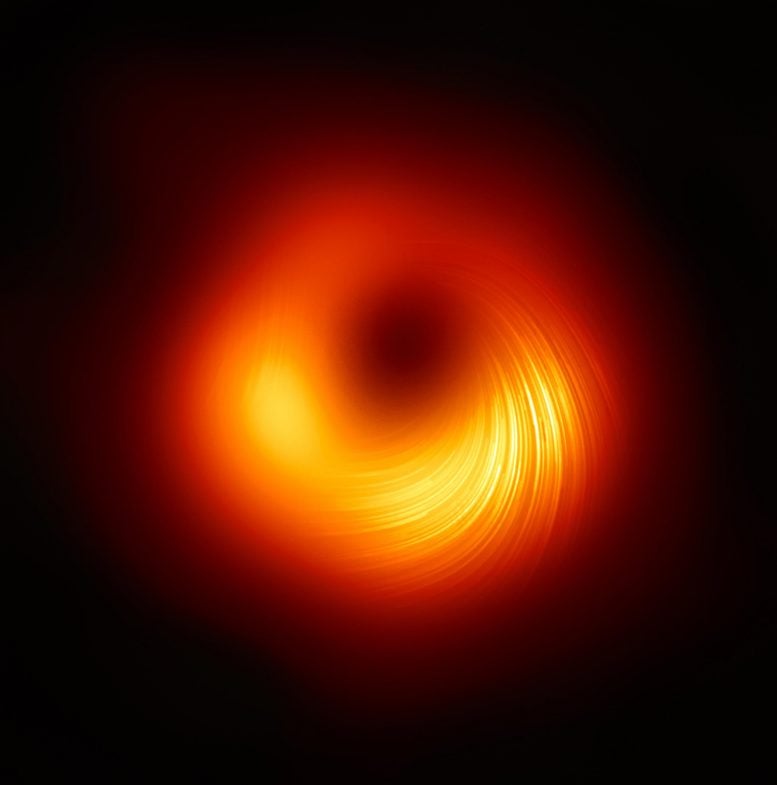
The Event Horizon Telescope (EHT) collaboration, who produced the first ever image of a black hole released in 2019, has today a new view of the massive object at the center of the Messier 87 (M87) galaxy: how it looks in polarized light. This image shows the polarized view of the black hole in M87. The lines mark the orientation of polarization, which is related to the magnetic field around the shadow of the black hole. Credit: EHT Collaboration
The Event Horizon Telescope (EHT) collaboration, which produced the first-ever image of a black hole, has today revealed a new view of the massive object at the center of the Messier 87 (M87) galaxy: how it looks in polarized light. This is the first time astronomers have been able to measure polarization, a signature of magnetic fields, this close to the edge of a black hole. The observations are key to explaining how the M87 galaxy, located 55 million light-years away, is able to launch energetic jets from its core.
“We are now seeing the next crucial piece of evidence to understand how magnetic fields behave around black holes, and how activity in this very compact region of space can drive powerful jets that extend far beyond the galaxy,” says Monika Mościbrodzka, Coordinator of the EHT Polarimetry Working Group and Assistant Professor at Radboud University in the Netherlands.
The Event Horizon Telescope (EHT) collaboration, who produced the first-ever image of a black hole, has today revealed a new view of the massive object at the center of the Messier 87 galaxy: how it looks in polarized light. This is the first time astronomers have been able to measure polarization, a signature of magnetic fields, this close to the edge of a black hole. This video summarizes the discovery.
On April 10, 2019, scientists released the first-ever image of a black hole, revealing a bright ring-like structure with a dark central region — the black hole’s shadow. Since then, the EHT collaboration has delved deeper into the data on the supermassive object at the heart of the M87 galaxy collected in 2017. They have discovered that a significant fraction of the light around the M87 black hole is polarized.
“This work is a major milestone: the polarization of light carries information that allows us to better understand the physics behind the image we saw in April 2019, which was not possible before,” explains Iván Martí-Vidal, also Coordinator of the EHT Polarimetry Working Group and GenT Distinguished Researcher at the University of Valencia, Spain. He adds that “unveiling this new polarized-light image required years of work due to the complex techniques involved in obtaining and analyzing the data.”
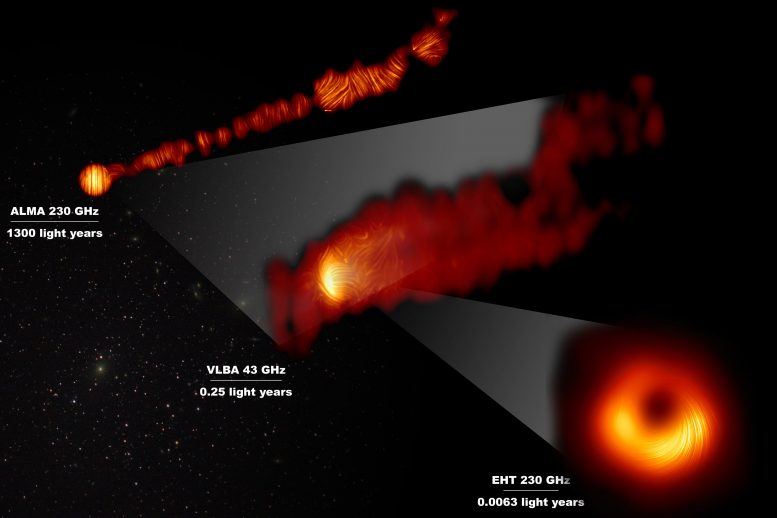
This composite image shows three views of the central region of the Messier 87 (M87) galaxy in polarized light and one view, in the visible wavelength, taken with the Hubble Space Telescope. The galaxy has a supermassive black hole at its center and is famous for its jets, that extend far beyond the galaxy. The Hubble image at the top captures a part of the jet some 6000 light-years in size.
One of the polarized-light images, obtained with the Chile-based Atacama Large Millimeter/submillimeter Array (ALMA), in which ESO is a partner, shows part of the jet in polarized light. This image captures the part of the jet, with a size of 6000 light-years, closer to the center of the galaxy.
The other polarized light images zoom in closer to the supermassive black hole: the middle view covers a region about one light-year in size and was obtained with the National Radio Astronomy Observatory’s Very Long Baseline Array (VLBA) in the US.
The most zoomed-in view was obtained by linking eight telescopes around the world to create a virtual Earth-sized telescope, the Event Horizon Telescope or EHT. This allows astronomers to see very close to the supermassive black hole, into the region where the jets are launched.
The lines mark the orientation of polarization, which is related to the magnetic field in the regions imaged. The ALMA data provides a description of the magnetic field structure along the jet. Therefore the combined information from the EHT and ALMA allows astronomers to investigate the role of magnetic fields from the vicinity of the event horizon (as probed with the EHT on light-day scales) to far beyond the M87 galaxy along its powerful jets (as probed with ALMA on scales of thousand of light-years).
The values in GHz refer to the frequencies of light at which the different observations were made. The horizontal lines show the scale (in light-years) of each of the individual images.
Credit: EHT Collaboration; ALMA (ESO/NAOJ/NRAO), Goddi et al.; NASA, ESA and the Hubble Heritage Team (STScI/AURA); VLBA (NRAO), Kravchenko et al.; J. C. Algaba, I. Martí-Vidal
Light becomes polarized when it goes through certain filters, like the lenses of polarized sunglasses, or when it is emitted in hot regions of space where magnetic fields are present. In the same way that polarized sunglasses help us see better by reducing reflections and glare from bright surfaces, astronomers can sharpen their view of the region around the black hole by looking at how the light originating from it is polarized. Specifically, polarization allows astronomers to map the magnetic field lines present at the inner edge of the black hole.
“The newly published polarized images are key to understanding how the magnetic field allows the black hole to ‘eat’ matter and launch powerful jets,” says EHT collaboration member Andrew Chael, a NASA Hubble Fellow at the Princeton Center for Theoretical Science and the Princeton Gravity Initiative in the US.
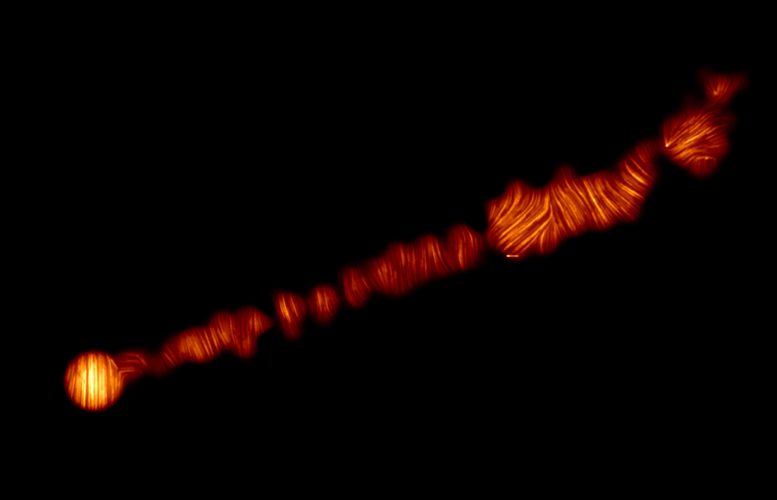
This image shows a view of the jet in the Messier 87 (M87) galaxy in polarized light. The image was obtained with the Chile-based Atacama Large Millimeter/submillimeter Array (ALMA), in which ESO is a partner, and captures the part of the jet, with a size of 6000 light-years, closer to the center of the galaxy. The lines mark the orientation of polarization, which is related to the magnetic field in the region imaged. This ALMA image therefore indicates what the structure of the magnetic field along the jet looks like. Credit: ALMA (ESO/NAOJ/NRAO), Goddi et al.
The bright jets of energy and matter that emerge from M87’s core and extend at least 5000 light-years from its center are one of the galaxy’s most mysterious and energetic features. Most matter lying close to the edge of a black hole falls in. However, some of the surrounding particles escape moments before capture and are blown far out into space in the form of jets.
Astronomers have relied on different models of how matter behaves near the black hole to better understand this process. But they still don’t know exactly how jets larger than the galaxy are launched from its central region, which is comparable in size to the Solar System, nor how exactly matter falls into the black hole. With the new EHT image of the black hole and its shadow in polarized light, astronomers managed for the first time to look into the region just outside the black hole where this interplay between matter flowing in and being ejected out is happening.
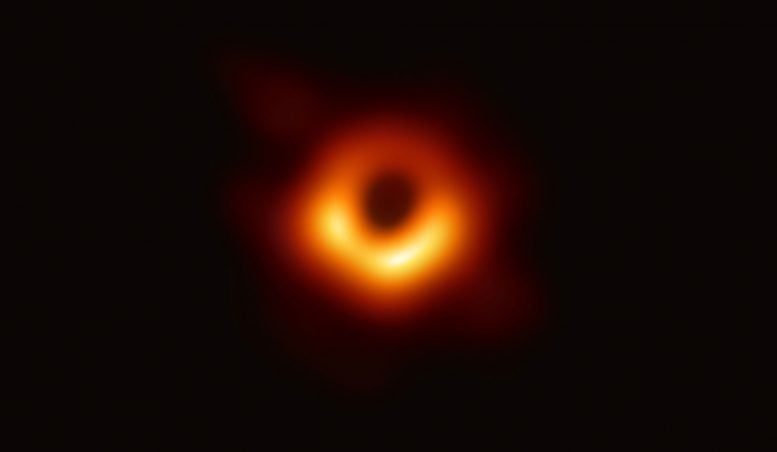
The shadow of a black hole seen here is the closest we can come to an image of the black hole itself, a completely dark object from which light cannot escape. The black hole’s boundary — the event horizon from which the EHT takes its name — is around 2.5 times smaller than the shadow it casts and measures just under 40 billion km across. While this may sound large, this ring is only about 40 microarcseconds across — equivalent to measuring the length of a credit card on the surface of the Moon. Credit: EHT Collaboration
The observations provide new information about the structure of the magnetic fields just outside the black hole. The team found that only theoretical models featuring strongly magnetized gas can explain what they are seeing at the event horizon.
“The observations suggest that the magnetic fields at the black hole’s edge are strong enough to push back on the hot gas and help it resist gravity’s pull. Only the gas that slips through the field can spiral inwards to the event horizon,” explains Jason Dexter, Assistant Professor at the University of Colorado Boulder, US, and Coordinator of the EHT Theory Working Group.
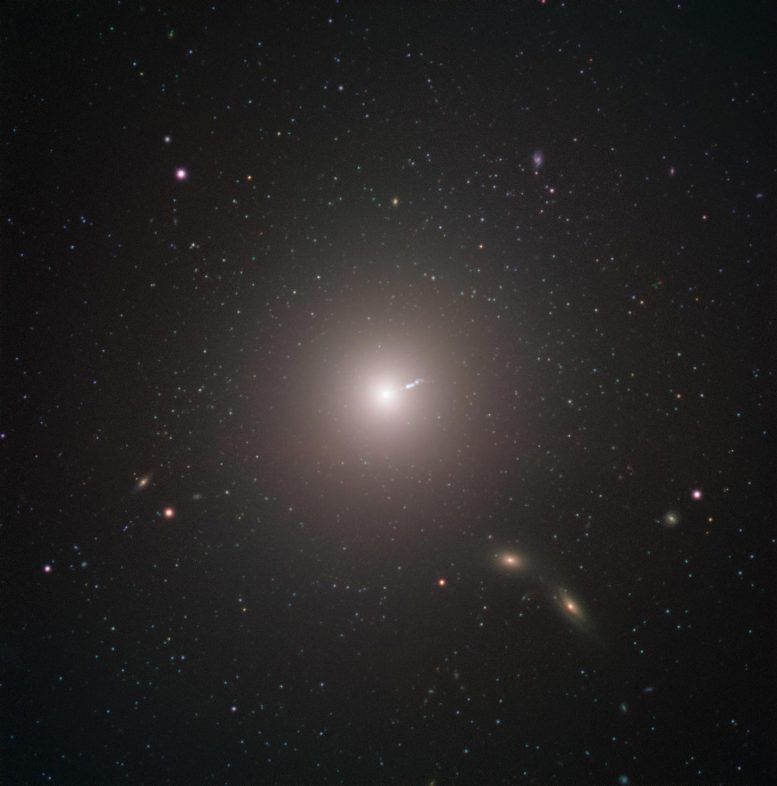
Messier 87 (M87) is an enormous elliptical galaxy located about 55 million light-years from Earth, visible in the constellation Virgo. It was discovered by Charles Messier in 1781, but not identified as a galaxy until 20th Century. At double the mass of our own galaxy, the Milky Way, and containing as many as ten times more stars, it is amongst the largest galaxies in the local universe. Besides its raw size, M87 has some very unique characteristics. For example, it contains an unusually high number of globular clusters: while our Milky Way contains under 200, M87 has about 12,000, which some scientists theorize it collected from its smaller neighbors.
This image was captured by FORS2 on ESO’s Very Large Telescope as part of the Cosmic Gems program, an outreach initiative that uses ESO telescopes to produce images of interesting, intriguing, or visually attractive objects for the purposes of education and public outreach. The program makes use of telescope time that cannot be used for science observations, and produces breathtaking images of some of the most striking objects in the night sky. In case the data collected could be useful for future scientific purposes, these observations are saved and made available to astronomers through the ESO Science Archive.
Credit: ESO
To observe the heart of the M87 galaxy, the collaboration linked eight telescopes around the world — including the northern Chile-based Atacama Large Millimeter/submillimeter Array (ALMA) and the Atacama Pathfinder EXperiment (APEX), in which the European Southern Observatory (ESO) is a partner — to create a virtual Earth-sized telescope, the EHT. The impressive resolution obtained with the EHT is equivalent to that needed to measure the length of a credit card on the surface of the Moon.
“With ALMA and APEX, which through their southern location enhance the image quality by adding geographical spread to the EHT network, European scientists were able to play a central role in the research,” says Ciska Kemper, European ALMA Programme Scientist at ESO. “With its 66 antennas, ALMA dominates the overall signal collection in polarized light, while APEX has been essential for the calibration of the image.”
“ALMA data were also crucial to calibrate, image and interpret the EHT observations, providing tight constraints on the theoretical models that explain how matter behaves near the black hole event horizon,” adds Ciriaco Goddi, a scientist at Radboud University and Leiden Observatory, the Netherlands, who led an accompanying study that relied only on ALMA observations.
The EHT setup allowed the team to directly observe the black hole shadow and the ring of light around it, with the new polarized-light image clearly showing that the ring is magnetized. The results are published today in two separate papers in The Astrophysical Journal Letters by the EHT collaboration. The research involved over 300 researchers from multiple organizations and universities worldwide.
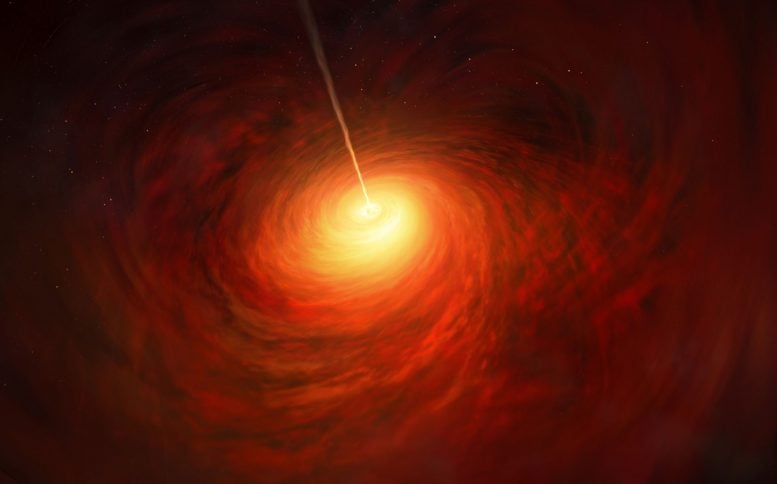
This artist’s impression depicts the black hole at the heart of the enormous elliptical galaxy Messier 87 (M87). This black hole was chosen as the object of paradigm-shifting observations by the Event Horizon Telescope. The superheated material surrounding the black hole is shown, as is the relativistic jet launched by M87’s black hole. Credit: ESO/M. Kornmesser
“The EHT is making rapid advancements, with technological upgrades being done to the network and new observatories being added. We expect future EHT observations to reveal more accurately the magnetic field structure around the black hole and to tell us more about the physics of the hot gas in this region,” concludes EHT collaboration member Jongho Park, an East Asian Core Observatories Association Fellow at the Academia Sinica Institute of Astronomy and Astrophysics in Taipei.
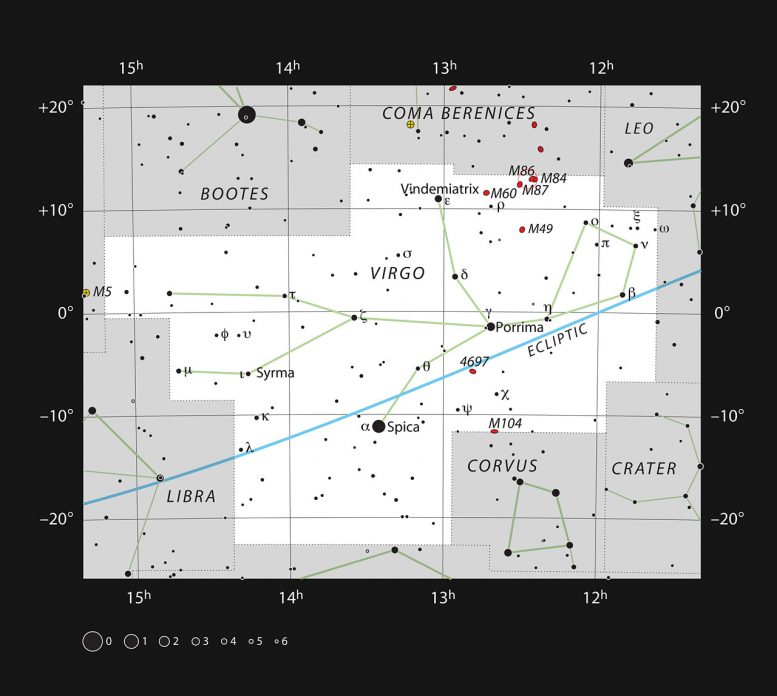
This chart shows the position of giant galaxy Messier 87 in the constellation of Virgo (The Virgin). The map shows most of the stars visible to the unaided eye under good conditions. Credit: ESO, IAU and Sky & Telescope
References
“First M87 Event Horizon Telescope Results. VII. Polarization of the Ring” by The Event Horizon Telescope Collaboration, Kazunori Akiyama, Juan Carlos Algaba, Antxon Alberdi, Walter Alef, Richard Anantua, Keiichi Asada, Rebecca Azulay, Anne-Kathrin Baczko, David Ball, et al., 24 March 2021, Astrophysical Journal Letters.
DOI: 10.3847/2041-8213/abe71d
“First M87 Event Horizon Telescope Results. VIII. Magnetic Field Structure near The Event Horizon” by The Event Horizon Telescope Collaboration, Kazunori Akiyama, Juan Carlos Algaba, Antxon Alberdi, Walter Alef, Richard Anantua, Keiichi Asada, Rebecca Azulay, Anne-Kathrin Baczko, David Ball, et al., 24 March 2021, Astrophysical Journal Letters.
DOI: 10.3847/2041-8213/abe4de
“Polarimetric Properties of Event Horizon Telescope Targets from ALMA” by Ciriaco Goddi, Iván Martí-Vidal, Hugo Messias, Geoffrey C. Bower, Avery E. Broderick, Jason Dexter, Daniel P. Marrone, Monika Moscibrodzka, Hiroshi Nagai, Juan Carlos Algaba, et al., 24 March 2021, Astrophysical Journal Letters.
DOI: 10.3847/2041-8213/abee6a
More information
This research was presented in two papers by the EHT collaboration published today in The Astrophysical Journal Letters: “First M87 Event Horizon Telescope Results VII: Polarization of the Ring” (doi: 10.3847/2041-8213/abe71d) and “First M87 Event Horizon Telescope Results VIII: Magnetic Field Structure Near The Event Horizon” (doi: 10.3847/2041-8213/abe4de). Accompanying research is presented in the paper “Polarimetric properties of Event Horizon Telescope targets from ALMA” (doi: 10.3847/2041-8213/abee6a) by Goddi, Martí-Vidal, Messias, and the EHT collaboration, which has been accepted for publication in The Astrophysical Journal Letters.
The EHT collaboration involves more than 300 researchers from Africa, Asia, Europe, North and South America. The international collaboration is working to capture the most detailed black hole images ever obtained by creating a virtual Earth-sized telescope. Supported by considerable international investment, the EHT links existing telescopes using novel systems — creating a fundamentally new instrument with the highest angular resolving power that has yet been achieved.
The individual telescopes involved are: ALMA, APEX, the Institut de Radioastronomie Millimetrique (IRAM) 30-meter Telescope, the IRAM NOEMA Observatory, the James Clerk Maxwell Telescope (JCMT), the Large Millimeter Telescope (LMT), the Submillimeter Array (SMA), the Submillimeter Telescope (SMT), the South Pole Telescope (SPT), the Kitt Peak Telescope, and the Greenland Telescope (GLT).
The EHT consortium consists of 13 stakeholder institutes: the Academia Sinica Institute of Astronomy and Astrophysics, the University of Arizona, the University of Chicago, the East Asian Observatory, Goethe-Universitaet Frankfurt, Institut de Radioastronomie Millimétrique, Large Millimeter Telescope, Max Planck Institute for Radio Astronomy, MIT Haystack Observatory, National Astronomical Observatory of Japan, Perimeter Institute for Theoretical Physics, Radboud University and the Smithsonian Astrophysical Observatory.
ESO is the foremost intergovernmental astronomy organization in Europe and the world’s most productive ground-based astronomical observatory by far. It has 16 Member States: Austria, Belgium, the Czech Republic, Denmark, France, Finland, Germany, Ireland, Italy, the Netherlands, Poland, Portugal, Spain, Sweden, Switzerland, and the United Kingdom, along with the host state of Chile and with Australia as a Strategic Partner. ESO carries out an ambitious program focused on the design, construction, and operation of powerful ground-based observing facilities enabling astronomers to make important scientific discoveries. ESO also plays a leading role in promoting and organizing cooperation in astronomical research. ESO operates three unique world-class observing sites in Chile: La Silla, Paranal, and Chajnantor. At Paranal, ESO operates the Very Large Telescope and its world-leading Very Large Telescope Interferometer as well as two survey telescopes, VISTA working in the infrared and the visible-light VLT Survey Telescope. Also at Paranal ESO will host and operate the Cherenkov Telescope Array South, the world’s largest and most sensitive gamma-ray observatory. ESO is also a major partner in two facilities on Chajnantor, APEX and ALMA, the largest astronomical project in existence. And on Cerro Armazones, close to Paranal, ESO is building the 39-meter Extremely Large Telescope, the ELT, which will become “the world’s biggest eye on the sky.”
The Atacama Large Millimeter/submillimeter Array (ALMA), an international astronomy facility, is a partnership of ESO, the U.S. National Science Foundation (NSF), and the National Institutes of Natural Sciences (NINS) of Japan in cooperation with the Republic of Chile. ALMA is funded by ESO on behalf of its Member States, by NSF in cooperation with the National Research Council of Canada (NRC) and the Ministry of Science and Technology (MOST) and by NINS in cooperation with the Academia Sinica (AS) in Taiwan and the Korea Astronomy and Space Science Institute (KASI). ALMA construction and operations are led by ESO on behalf of its Member States; by the National Radio Astronomy Observatory (NRAO), managed by Associated Universities, Inc. (AUI), on behalf of North America; and by the National Astronomical Observatory of Japan (NAOJ) on behalf of East Asia. The Joint ALMA Observatory (JAO) provides the unified leadership and management of the construction, commissioning, and operation of ALMA.
The BlackHoleCam research group was awarded the European Research Council €14 million Synergy Grant in 2013. The Principal Investigators are Heino Falcke, Luciano Rezzolla and Michael Kramer and the partner institutes are JIVE, IRAM, MPE Garching, IRA/INAF Bologna, SKA and ESO. BlackHoleCam is part of the Event Horizon Telescope collaboration.







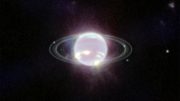
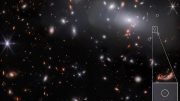
hi me name jeff
Wow , looking at the edge of space and time. This goes way beyond anything we could ever create in a lab. As we see more clearly , should be able to see the breakdown of time and space as it’s also absorbed into the black hole.
If you have proton electron pairs as constituent matter of relativistic jets, would that implicate the black hole as nature’s highest-energy particle collider? And represents the near complete conversion of matter into energy?
Have the proton electron pairs, as the constituent matter of relativistic jets, gained their mass through their velocity? Would they decay upon reaching non-relativistic speed?
The so-called black hole of M87 is only an artifact (The jet and resolved features of the central supermassive black hole of M87 observed with EHT”, May 20, 2022. https://arxiv.org/pdf/2205.04623.pdf). I agree completely given the total absence of proof for the existence of ANY black hole.
The jets ejection from opposite sides of rotating plasma disc around the supermassive black hole due to rotation of galaxy with respect to others in time axis is an established phenomena.
This event of splitting up of only jets’ pair into two or more compĺex pairs of jets have been observed with unclear faint image with poor resolution to be figured out in some other galaxies.
For the first time at two different points in opposite direction of supermassive black hole in galaxy M87 pairs of jets are obseved.Ofcourse,more one position is also observed in jet ejection event.
Thus,this new observation in galaxy M87 gives an insight about Geometrical Structure of the Universe.Here,rotation exerts a torque to generate jets at two points in opposite directions of supermassive black hole along the gyroscopic axis present at center of the galaxy.